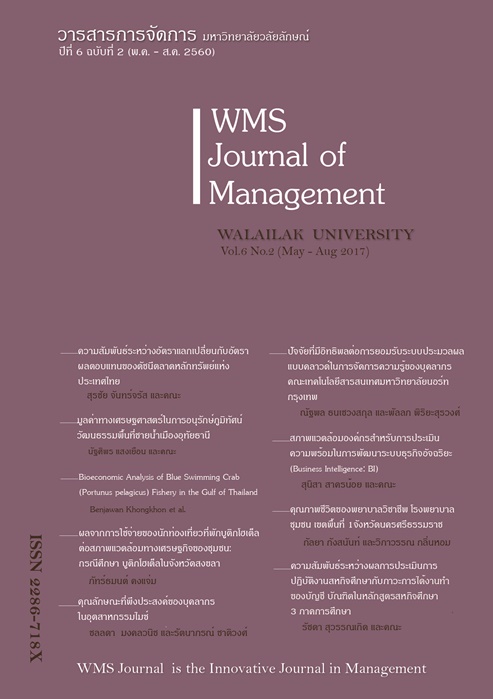Result of Boutique Hotel Tourists' Expenditure to Economic Environment of Community: A Case Study of Boutique Hotels in Songkhla Province
Main Article Content
Abstract
Article Details
References
กรมการท่องเที่ยว. 2557. สถิตินักท่องเที่ยว 2012. สืบค้นจาก http://newdot2.samartmultimedia.com/home/details/11/221/620
การท่องเที่ยวแห่งประเทศไทย. 2556. Thailand 100 best boutique hotels.กรุงเทพฯ: กองส่งเสริมการบริการท่องเที่ยว.
ธนิถา แสงวิเชียร. 2555. การศึกษาแนวคิดบูติกและไลฟ์สไตล์โฮเต็ลเพื่อนำไปสู่การเพิ่มมูลค่าแก่ธุรกิจโรงแรมในจังหวัดสงขลา. วิทยานิพนธ์ปริญญามหาบัณฑิต มหาวิทยาลัยสงขลานครินทร์.
พรเพ็ญ ศานติ์สุทธิกุล. 2542. ผลทางด้านเศรษฐกิจของการใช้จ่ายของนักท่องเที่ยวในประเทศไทย กรณีนักท่องเที่ยวระหว่างประเทศปี พ.ศ.2539. วิทยานิพนธ์ปริญญามหาบัณฑิต มหาวิทยาลัยเกษตรศาสตร์.
พิสมัย จารุจิตติพันธ์. 2536. ผลกระทบของการพัฒนาอุตสาหกรรมท่องเที่ยวต่อเศรษฐกิจในเกาะสมุย.วิทยานิพนธ์ปริญญาดุษฎีบัณฑิต มหาวิทยาลัยศรีนครินทรวิโรฒ.
ภาคภูมิ สินุธก. 2547. ผลกระทบจากการใช้จ่ายของนักท่องเที่ยวต่อรายได้และการจ้างงานของภาคตะวันออกเฉียงเหนือ กรณีศึกษาโดยใช้แบบจำลองปัจจัยการผลิต-ผลผลิต. วิทยานิพนธ์ปริญญาดุษฎีบัณฑิต มหาวิทยาลัยธรรมศาสตร์.
วชิราพร เกิดสุข และคณะ. 2544. รายงานการวิจัย บทบาทของอุตสาหกรรมท่องเที่ยวในจังหวัดนครราชสีมาต่อการจ้างงาน กรณีศึกษาการท่องเที่ยว ณ อุทยานแห่งชาติเขาใหญ่ และอุทยานประวัติศาสตร์พิมาย. ขอนแก่น: สถาบันวิจัยและพัฒนา มหาวิทยาลัยขอนแก่น.
ศรีสุรางค์ สุนทรกุล. 2536. ผลกระทบของอุตสาหกรรมท่องเที่ยวที่มีต่อการพัฒนาเศรษฐกิจในท้องถิ่น : กรณีศึกษาจังหวัดเชียงราย. วิทยานิพนธ์ปริญญามหาบัณฑิต มหาวิทยาลัยรามคำแหง.
ศูนย์วิจัยกสิกร. 2555. Boutique hotel: ที่พักรูปแบบใหม่ที่กำลังมาแรงในปัจจุบัน. สืบค้นจาก http://www.ksmecare.com/article/82/27821/boutique-%20hotel
สำนักงานสถิติแห่งชาติ. 2557. จำนวนผู้เยี่ยมเยือน จำแนกเป็นรายภาคและจังหวัด พ.ศ.2549-2554. สืบค้นจาก http://service.nso.go.th/nso/web/
statseries/statseries23.html
สำนักดัชนีเศรษฐกิจการค้า. 2557. ดัชนีราคาผู้บริโภคระดับจังหวัด. สืบค้นจาก http://www.price.moc.go.th/
Agget, M. 2007. What has influenced growth in the UK’s boutique hotel sector?. International Journal of Contemporary Hospitality Management, 10(2), 169-177.
Albazzaz, A., Birnbaum, B., Brachfeld, D., Danilov, D., Kets De Vries, O., & Moed, J. 2003. Lifestyles of the rich and almost famous: The boutique hotel phenomenon in the United States. High Tech Entrepreneurship and Strategy Group Project. Fontainebleau: Insead Business School.
Anhar, L. 2001. The definition of boutique hotels. Retrieved from http://www.hospitalitynet.org.definition/american_english/boutique
Erkutlu, H. V. & Chafra, J. 2005. Relationship between leadership power bases and job stress of subordinates: Example from boutique hotels. Management Research News, 29(5), 285-297.
Geoffrey J. D. Hewings. 1985. Regional input-output table analysis. California, CA: Sage Publications.
Keynes, J. M. 1936. General theory of home investment to unemployment. New York, NY: Harcourt, Brace & Co.
Leontief, W. 1966. Input-Output Economics. New York, NY: Oxford University Press.
Lim, W., & Endean, M. 2009. Elucidating the aesthetic and operational characteristic of UK boutique hotels. International Journal of Contemporary Hospitality Management, 21(1), 38-51.
McIntosh, A. J., & Siggs, A. 2005. An exploration of the experiential nature of boutique accommodation. Journal of Travel Research, 44(1), 74-81.


